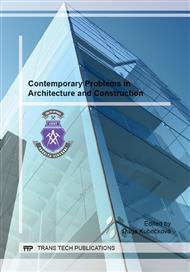p.204
p.210
p.215
p.221
p.227
p.233
p.238
p.242
p.248
Experimental Testing the Interaction of Fiber-Concrete Foundation Slab and Subsoil and Compare the Results with Numerical Models
Abstract:
We solve interaction between the foundation base and the subsoil in civil engineering quite often. For the determination of stress in foundation structure is needed to determine the influence of the stiffness respectively pliability of subsoil to structural internal forces, and vice versa, how the stiffness of the foundation structure affects the resulting subsidence. It is necessary to compare the mathematical models with the actual behavior of the real structure. In 2013 was realised static load on testing equipment in the campus of Faculty of Civil Engineering, VSB–TU Ostrava. Dimensions of test element was 2000 x 2000 x 170 mm and the concrete slab was reinforced with steel fiber type DRAMIX 3D 65/60B6. During measurements were performed and recorded: tensometrical measurement on the surface of the slab, tensometrical measurement inside the slab, measuring the vertical load, measurement of the vertical deformation, measuring the stress on the interface of the slab and soil. Were also developed numerical models of this test in program Nexis. Comparison the test results with numerical models are presented in this paper. [1,9]
Info:
Periodical:
Pages:
227-232
Citation:
Online since:
October 2014
Authors:
Price:
Сopyright:
© 2014 Trans Tech Publications Ltd. All Rights Reserved
Share:
Citation:


